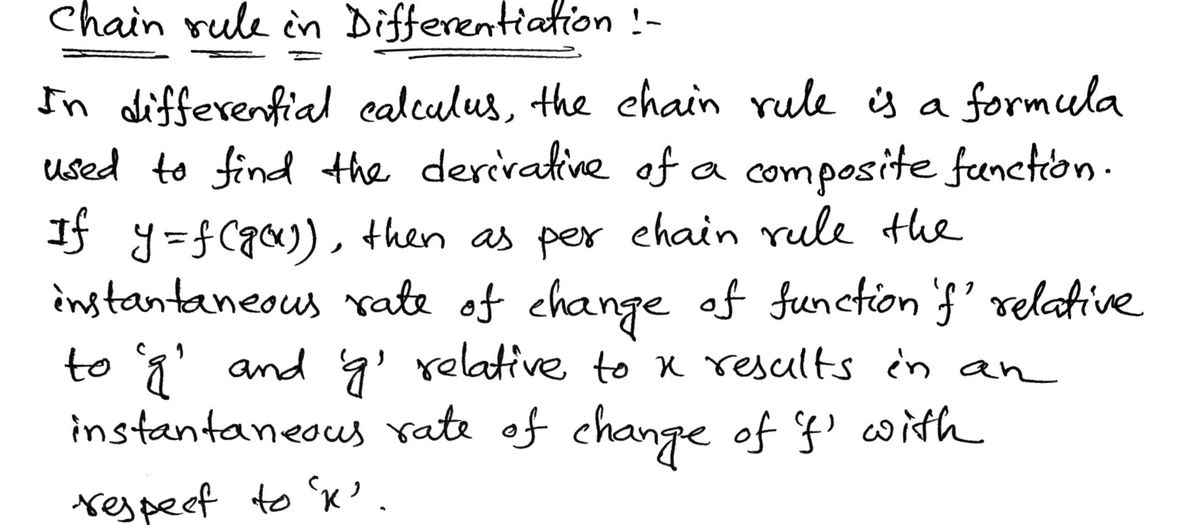A table of values for f, g, f', and g' is given. g(x) 2 8 2 Xx 1 2 3 f(x) 3 1 7 (a) If h(x) = f(g(x)), find h'(1). h'(1) = (b) If H(x) = g(f(x)), find H'(1). H'(1) = X f'(x) 4 5 7 g'(x) 6 7 9
A table of values for f, g, f', and g' is given. g(x) 2 8 2 Xx 1 2 3 f(x) 3 1 7 (a) If h(x) = f(g(x)), find h'(1). h'(1) = (b) If H(x) = g(f(x)), find H'(1). H'(1) = X f'(x) 4 5 7 g'(x) 6 7 9
Calculus: Early Transcendentals
8th Edition
ISBN:9781285741550
Author:James Stewart
Publisher:James Stewart
Chapter1: Functions And Models
Section: Chapter Questions
Problem 1RCC: (a) What is a function? What are its domain and range? (b) What is the graph of a function? (c) How...
Related questions
Question
100%
![### Table of Values for Derivatives
A table of values for functions \( f \), \( g \), and their derivatives \( f' \), and \( g' \) is given.
| \( x \) | \( f(x) \) | \( g(x) \) | \( f'(x) \) | \( g'(x) \) |
|---------|-----------|-----------|-------------|-------------|
| 1 | 3 | 2 | 4 | 6 |
| 2 | 1 | 8 | 5 | 7 |
| 3 | 7 | 2 | 7 | 9 |
### Questions
#### (a) If \( h(x) = f(g(x)) \), find \( h'(1) \).
\[ h'(1) = \boxed{} \]
#### (b) If \( H(x) = g(f(x)) \), find \( H'(1) \).
\[ H'(1) = \boxed{} \]
**Explanation:**
1. To find \( h'(1) \) for \( h(x) = f(g(x)) \), use the chain rule:
\[
h'(x) = f'(g(x)) \cdot g'(x)
\]
2. To find \( H'(1) \) for \( H(x) = g(f(x)) \), also use the chain rule:
\[
H'(x) = g'(f(x)) \cdot f'(x)
\]
Understanding these calculations will help solve for the derivatives of composite functions using given function values and their derivatives.](/v2/_next/image?url=https%3A%2F%2Fcontent.bartleby.com%2Fqna-images%2Fquestion%2F6a2a18af-6188-482f-813a-e68f87e43dd9%2F258f4523-884b-47ee-866f-c45e2e1cdd2e%2Fv0icwqa_processed.jpeg&w=3840&q=75)
Transcribed Image Text:### Table of Values for Derivatives
A table of values for functions \( f \), \( g \), and their derivatives \( f' \), and \( g' \) is given.
| \( x \) | \( f(x) \) | \( g(x) \) | \( f'(x) \) | \( g'(x) \) |
|---------|-----------|-----------|-------------|-------------|
| 1 | 3 | 2 | 4 | 6 |
| 2 | 1 | 8 | 5 | 7 |
| 3 | 7 | 2 | 7 | 9 |
### Questions
#### (a) If \( h(x) = f(g(x)) \), find \( h'(1) \).
\[ h'(1) = \boxed{} \]
#### (b) If \( H(x) = g(f(x)) \), find \( H'(1) \).
\[ H'(1) = \boxed{} \]
**Explanation:**
1. To find \( h'(1) \) for \( h(x) = f(g(x)) \), use the chain rule:
\[
h'(x) = f'(g(x)) \cdot g'(x)
\]
2. To find \( H'(1) \) for \( H(x) = g(f(x)) \), also use the chain rule:
\[
H'(x) = g'(f(x)) \cdot f'(x)
\]
Understanding these calculations will help solve for the derivatives of composite functions using given function values and their derivatives.
Expert Solution
Step 1: chain rule of differentiation

Trending now
This is a popular solution!
Step by step
Solved in 3 steps with 3 images

Recommended textbooks for you

Calculus: Early Transcendentals
Calculus
ISBN:
9781285741550
Author:
James Stewart
Publisher:
Cengage Learning

Thomas' Calculus (14th Edition)
Calculus
ISBN:
9780134438986
Author:
Joel R. Hass, Christopher E. Heil, Maurice D. Weir
Publisher:
PEARSON

Calculus: Early Transcendentals (3rd Edition)
Calculus
ISBN:
9780134763644
Author:
William L. Briggs, Lyle Cochran, Bernard Gillett, Eric Schulz
Publisher:
PEARSON

Calculus: Early Transcendentals
Calculus
ISBN:
9781285741550
Author:
James Stewart
Publisher:
Cengage Learning

Thomas' Calculus (14th Edition)
Calculus
ISBN:
9780134438986
Author:
Joel R. Hass, Christopher E. Heil, Maurice D. Weir
Publisher:
PEARSON

Calculus: Early Transcendentals (3rd Edition)
Calculus
ISBN:
9780134763644
Author:
William L. Briggs, Lyle Cochran, Bernard Gillett, Eric Schulz
Publisher:
PEARSON

Calculus: Early Transcendentals
Calculus
ISBN:
9781319050740
Author:
Jon Rogawski, Colin Adams, Robert Franzosa
Publisher:
W. H. Freeman


Calculus: Early Transcendental Functions
Calculus
ISBN:
9781337552516
Author:
Ron Larson, Bruce H. Edwards
Publisher:
Cengage Learning